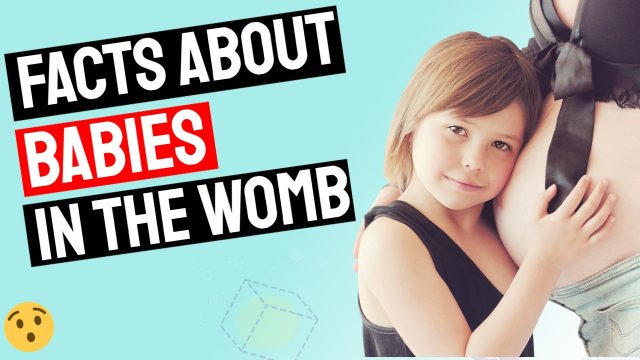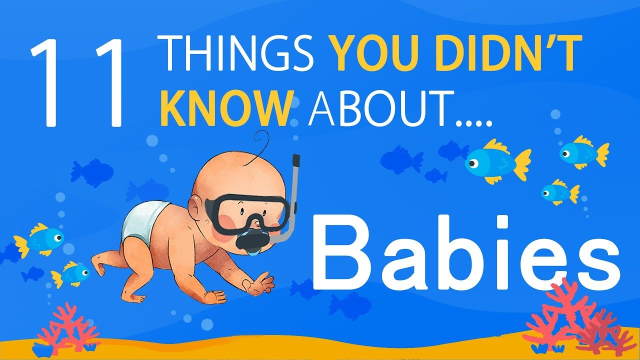There are many intriguing and little known facts about babies in the womb which we thought our readers would find interesting, especially for new Moms to be.
Children grow up really fast. In one moment there is nothing more than a few cells and almost immediately vital organs are being built. It's not surprising that there is a lot to know which medics have found out, about babies which we thought our readers would find interesting, especially for new Moms to be.

There are only forty weeks from conception to independent life. Not too long after that they begin forming personalities and even making their own decisions. You probably already know a few facts about babies, such as:
- that they cannot change their own diapers and that
- they don't yet know how to speak and that
- it takes them a while to figure out how to move on their own.
Here are some facts about babies in the womb that you might not know.
Can My Baby See Anything in My Womb?
Babies are sensitive to light before they are born. Your eyes are incredibly complicated devices. You would be surprised by just how much coordination is needed for your eyes to work properly. Babies usually have working eyes by the end of the first trimester or very beginning of the second trimester. Even as early as six months after conception your baby will show signs of light sensitivity.
Will My Babies Eyes Change Color?
Maybe they will change from their color while in the womb. If a baby's eyes are going to change color from the color in the womb, they do this a few months after birth. Many caucasian babies are born with blue eyes and it takes a few months for the eyes to change to their permanent color. Caucasian babies do not usually keep their “original” eye color (blue). So, if this is you, do what you can to be rational about this if your baby has blue eyes at birth and do not to let your heart get set on having a blue-eyed child. Your baby's eyes will probably change color!
How Soon Can Babies Really Talk?
The vocal range of babies is very impressive; even if it does take them a while to use those vocal cords to make words that adults can understand. This is because the larynx (or voice box) is still developing after babies are born. The flexibility of a new voice box is what makes the baby's range better than an adult's range. Babies quickly start to assign the sounds they make to the things that they want or need. This is what teaches a mother to identify what it is her baby needs or wants simply by listening to the sounds he is making.
A baby's first words usually come from the front of the mouth and are often accidental consonants broken up by vowels. This is why “Dada” is usually said before “Mama”, namely because “Mama” is harder for a baby to learn to say, but “Dada” usually happens almost by accident!
Do Babies Really Have Tails in the Womb?
Did you know that when first developing in the womb, babies grow tails? That is no lie! As your baby's cells divide, the major organs (heart, lungs, brain) begin to form and so does a tail!
The tail will begin to disappear as the rest of the baby's body takes shape as it grows inside the mother's womb. The process is sort of like the way a tadpole's tail gets swallowed up by the body of the frog. Unfortunately, not everyone's body will absorb the tail completely and some babies are born with short tails still sticking out.
Surgical removal and waiting for it to be grown into are the two options that are available to parents whose babies are born with intact tails. Thankfully, the tail has no bearing on the rest of the child's health and can be removed without worry. (Don't take our word for it thought – always take medical advice!)
Do Babies Cry in the Womb?
Pregnant women often ask this. This was not known until the advent of ultrasound videos, after all the baby is surrounded by amniotic fluid, so the sound is not audible. After playing a sound on the pregnant mothers' bellies, ultrasound videos show babies startling, opening their mouths, and gasping. So, it must be assumed that, in a way, they do have the ability to cry.
Concluding Our Development Facts About Babies in the Womb
The fact is that most knowledge about fetal development of babies in the womb not widely known. Early childhood development, while you are pregnant, is amazing. Learning what is going on with your baby as he grows up will make the process even more rewarding.
The above tips may be useful for yourself as well as for your baby through and after the pregnancy. Your baby's physical development is a thing of beauty and a source of pride. From sitting to crawling, walking to talking, smiling to laughing, each achievement is a developmental milestone.
Do you change your voice when you are with a baby? Many people do this, and babies like it. The slow, repetitive, musical style of speaking is called “infant-directed speech, ” and it appears to help babies understand our emotions. Studies also suggest that making eye contact during a conversation helps babies “tune in.” It's a signal that tells babies we attempting to convey something meaningful.

There's evidence that we help our babies by making expressive gestures. This helps them decipher new words, like pointing at an object we're talking about. And it's plausible that “baby sign language” improves communication between parents and infants. This may benefit the parent-child relationship as well.
We hope you enjoyed reading our facts about babies in the womb!
It is good, as a parent, to watch your baby's development through the stages of development listed by the experts. But, don't take these too literally. Babies do not develop at the same rate. There is a wide range of what is considered “normal.” Your baby may be ahead in some areas and slightly behind in others. If you are worried about possible delays, talk to your baby's health care provider.
You may also find more information about pregnancy if you click here.


Looking forward to reading more. Great blog.Thanks Again. Really Cool.
I really like and appreciate your article post. Much thanks again. Want more.